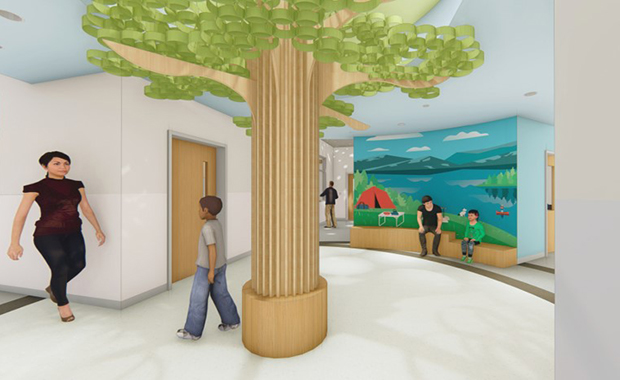In 2014 E4H Architecture, worked with Dr. Matthew Siegel, director of the developmental disorders program of Maine Behavioral Healthcare (MBH) in Portland, Maine, to design a Center of Autism and Developmental Disorders, known as the CADD Program, for MBH. The program brought MBH’s day treatment program, outpatient services, and research for autism together in one location in an environment designed to serve the needs of patients, families, and staff. The CADD Program flourished and it quickly outgrew its 7,600-square-foot building.
Dr. Siegel again approached E4H with a vision to develop a new comprehensive center that would be large enough to house multiple programs, resulting in a facility three times the original, with 1,850 square feet allocated for future growth if demand grew. The 28,000-square-foot regional center, expected to open in August 2021, consolidates several services under one roof, including an the Early Childhood Program with a fully equipped classroom that features wearable biosensors, on-site computing and display capabilities to support MBH’s studies of physiology, emotion and behavior; a research and training program; and an adult program to meet the needs of the adult developmental disorders’ population in Maine.
The design of the project is inspired by nature and is largely driven by evidence-based research that is supportive of environments for children and adults with developmental disorders. Oak wood tones and organic patterns will add warmth and a sense of familiarity into the space, while wall protection and paint will be utilized to add color and graphics. Rubber and textile composite flooring were chosen to provide underfoot comfort, which will be beneficial for both patients and staff.
Over-stimulation is a concern for those on the spectrum, while lack of visual interest or variation can hinder growth and prevent acclimatization to neurotypical environments found in the outside world. To address this, brighter and more saturated colors, along with texture and pattern, are used in higher-stimulation spaces such as the gymnasium and a central gathering space used to create sensory experiences. In contrast, rooms requiring higher concentration utilize more muted accents of color, indirect lighting, and absorptive acoustic finishes to reduce potential distractions.
Lighting and acoustics were important design considerations, as they can both be a trigger for hypersensitive individuals. A layered lighting approach of clerestory windows, indirect lighting, and task lighting was developed to maximize flexibility and control, while acoustics were addressed using finishes with noise reduction and sound absorption qualities.
Spaces are grouped into different stimulus zones, reflective of patients’ varying degrees of activity, skill level, and sensory intensity, to encourage children to navigate independently. Transitions between the different zones are provided to allow children to recalibrate their senses, including alcoves located outside and inside each classroom space and widened corridor intersections that provide views to what spaces lie ahead when walking through the facility.
Project details:
Facility name: Maine Behavioral Healthcare Center of Autism and Developmental Disorders
Location: Portland, Maine
Expected completion date: August 2021
Owner: Maine Behavioral Healthcare
Total building area: 28,000 sq. ft.
Total construction cost: $11 million
Cost/sq. ft.: $402
Architecture firm: E4H Environments for Health
Interior design: E4H Environments for Health
Contracting: Langford and Low
Engineering: Stantec (MEP/FP); Foley Buhl Roberts & Associates Inc. (structural); Ransom (civil); Barry J. Hosmer (landscape architect)













